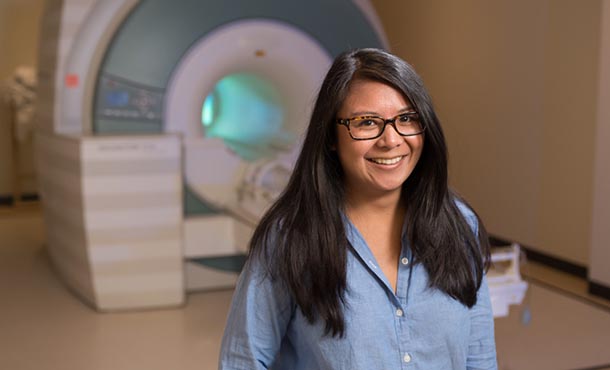
Nina Lauharatanahirun, assistant professor, is the first joint hire between the Department of Biomedical Engineering and the Department of Biobehavioral Health at Penn State. IMAGE: NINA LAUHARATANAHIRUN
Multidisciplinary researcher bridges Penn State departments as first joint hire
Nina Lauharatanahirun uses engineering tools to understand biological mechanisms underlying psychological phenomena, such as decision making
1/27/2021
By Ashley J. WennersHerron
UNIVERSITY PARK, Pa. — Nina Lauharatanahirun joined Penn State’s College of Engineering and College of Health and Human Development on Jan. 1 as an assistant professor of biomedical engineering and biobehavioral health. She is the first joint hire for the departments, bridging precision engineering with neuroscience and psychology to study risky decision-making in individuals, with a focus on adolescents, and in teams.
“The leading causes of mortality in adolescents — all linked to decision-making — are all preventable,” Lauharatanahirun said, referring to the top three causes as listed by the Centers for Disease Control and Prevention: accidents, homicides and suicides. “Adolescence is a special time in development that can set patterns of behavior that have the potential to set you on a positive or negative health trajectory with long-term impacts.”
Lauharatanahirun recently completed a postdoctoral fellowship with the U.S. Army Research Laboratory in the U.S. Department of Defense and the Annenberg School for Communication at the University of Pennsylvania. She earned her master’s and doctoral degrees in neuroscience and biological psychology at Virginia Tech after completing her bachelor’s degree in psychology at California State University.
During most of her training, she studied how and why adolescents make decisions under uncertain conditions and how teams of humans work with artificial intelligence to make decisions.
“Risky decisions can be classified on a spectrum from negative to positive — especially in a social context,” Lauharatanahirun said. “We’re a very social society, and we’re always making decisions that impact our families or friends, just as their opinions can influence our decisions. That’s amplified in adolescents, who are highly influenced by their peers.”
Lauharatanahirun said she is particularly interested in the mechanism of social influence in adolescents, who are in the process of developing social norms, to understand how it affects decision-making and how it can be leveraged to encourage healthier choices.
“To be clear, adolescents should be taking risks — that’s part of learning,” Lauharatanahirun said. “There’s risk in something like smoking, but there’s also risk in playing sports. How do we understand how adolescents perceive these risks and translate that knowledge to promote positive decisions? I am excited about creating neural engineering solutions to promote positive health behaviors.”
By scanning the brains of adolescents playing risky games in an MRI machine, Lauharatanahirun can begin to elucidate the neural mechanisms that support taking risks. She is working to develop interventions, such as neurofeedback, that can regulate risk-related brain signals to help both individuals and groups take healthier risks, such as trying out for a team or taking a new class.
“The plan is to develop algorithms that can incorporate information about how risk is processed in the brain,” Lauharatanahirun said. “Using this information, we can build technologies that adapt behavior by giving a person the right motivation at the right time for the right behavior.”
To support her research program, Lauharatanahirun will recruit students from the biomedical engineering and biobehavioral health programs interested in interdisciplinary research that combines economics, engineering, computer science and psychology.
“This position is at the intersection of where I see my work of developing adaptive technology and understanding the core mechanisms of these health behaviors across the lifespan,” Lauharatanahirun said. “Both departments have high-caliber researchers, and I’m looking forward to collaborating with new colleagues and mentoring students.”
Cheng Dong, distinguished professor and department head of biomedical engineering, said the department is excited to have her join the University and bolster innovative collaboration across disciplines.
“Dr. Lauharatanahirun’s work applies technology to human behavior in order to understand, and maybe modify, decision-making,” Dong said. “She brings a unique tool set to study decision-making and human health by engineering computational modeling and machine learning to understand the neural mechanisms underlying these choices.”
Tom Gould, Jean Phillips Shibley Professor of Biobehavioral Health and department head of biobehavioral health, agreed.
“When the opportunity to pursue a joint hire that would bridge biobehavioral health and biomedical engineering arose, we were excited,” Gould said. “The successful hiring of Dr. Lauharatanahirun has amplified and sustained that excitement. She brings a cutting-edge approach to studying health risk behaviors, employing state-of-the-art computer modeling with neural imaging to understand the behavioral economics of health-related decision making across the lifespan. Her work indeed bridges and brings our two departments together.”



